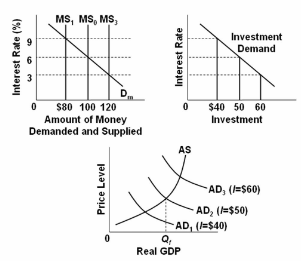Assume that a monopolist faces the demand schedule given below, and a constant marginal cost of $2 for each unit of output. To maximize profits, this monopolist would produce ____ units of output and charge a price of ____ per unit.
a. 1 unit; $8
b. 2 units; $5
c. 3 units; $3
d. 4 units; $1
b. 2 units; $5
You might also like to view...
The fact that it takes time for government to identify and recognize a problem is one reason for the occurrence of
A) implementation lags. B) outside lags. C) inside lags. D) structural lags.
According to the ability-to-pay principle, it is fair for people to pay taxes based on the amount of government services that they receive
a. True b. False Indicate whether the statement is true or false
What country is the world's largest exporter of services?
(A) Germany (B) United States (C) Great Britain (D) Japan
Refer to the diagrams. The numbers in parentheses after the AD 1 , AD 2 , and AD 3 labels indicate the levels of investment spending associated with each curve. All figures are in billions. If aggregate demand is AD 3 and the monetary authorities desire to reduce it to AD 2 , they should:

A. increase the interest rate from 3 percent to 9 percent.
B. increase the money supply from $100 to $120.
C. decrease the money supply from $120 to $100.
D. decrease the interest rate from 3 percent to 9 percent.